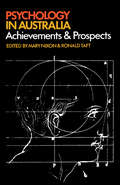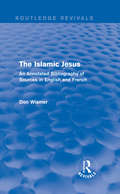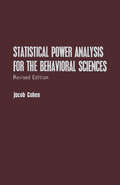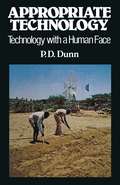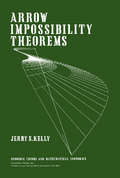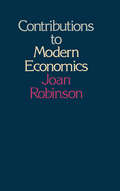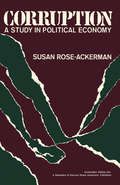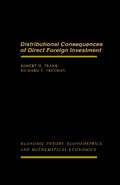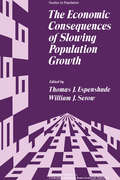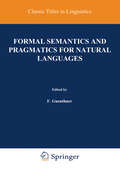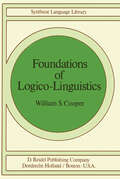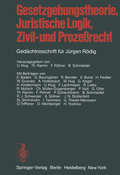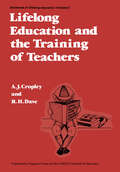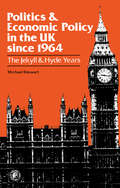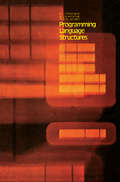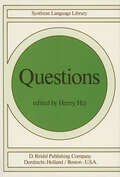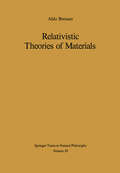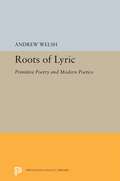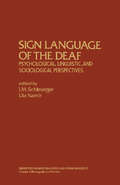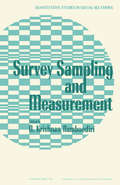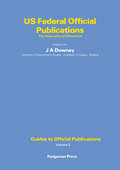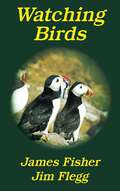- Table View
- List View
Psychology in Australia: Achievements & Prospects
by Mary Nixon Ronald TaftPsychology in Australia: Achievements & Prospects is an assessment of the achievements and prospects of the field of psychology in Australia. Issues related to teaching and research are examined, and research areas that are flourishing, as well as those that are floundering or neglected, are highlighted. The main emphasis is on fields of endeavor in which psychology is applied to individual, social, and organizational issues. This book is comprised of 22 chapters and begins with an introduction to the first phases of teaching and practice of psychology in Australia, followed by a historical overview of applied psychology in the country. Subsequent chapters explore the influence of culture on Australian psychology; psychological research in universities and colleges, in clinical and counseling psychology, and in health education; and the training and education of psychologists in Australia. Some applications of psychology are also discussed, along with private practice in Australian psychology. The final chapter focuses on Australian psychologists in the world context. This monograph should be of interest to students and general readers as well as to psychologists themselves.
Routledge Revivals (1977): An Annotated Bibliography of Sources in English and French
by Don WismerFirst published in 1977, this book is intended as a record of sources in Islamic prophetology which focus on the prophet Isa — Jesus in Christian theology. The Islamic Isa differs markedly from the Christian Jesus, most obviously in that, although considered an important prophet, he is overshadowed by Muhammad. The doctrine of tawhid — the indivisible oneness of God — also necessarily means the rejection of Christ’s incarnation or dual nature. The primary of role of Jesus in Islam, as with all Islamic prophets, is to reaffirm the primeval religion of man, best expressed by the Shadada and Islam. This book collects, as comprehensively as possible, bibliographic sources in English and French from the time of the earliest available texts (circa 1650) providing annotated commentary and source information — making it an invaluable research tool for anyone who wishes to study the Islamic Jesus in more detail.
Routledge Revivals (1977): An Annotated Bibliography of Sources in English and French
by Don WismerFirst published in 1977, this book is intended as a record of sources in Islamic prophetology which focus on the prophet Isa — Jesus in Christian theology. The Islamic Isa differs markedly from the Christian Jesus, most obviously in that, although considered an important prophet, he is overshadowed by Muhammad. The doctrine of tawhid — the indivisible oneness of God — also necessarily means the rejection of Christ’s incarnation or dual nature. The primary of role of Jesus in Islam, as with all Islamic prophets, is to reaffirm the primeval religion of man, best expressed by the Shadada and Islam. This book collects, as comprehensively as possible, bibliographic sources in English and French from the time of the earliest available texts (circa 1650) providing annotated commentary and source information — making it an invaluable research tool for anyone who wishes to study the Islamic Jesus in more detail.
Statistical Power Analysis for the Behavioral Sciences
by Jacob CohenStatistical Power Analysis for the Behavioral Sciences, Revised Edition emphasizes the importance of statistical power analysis. This edition discusses the concepts and types of power analysis, t test for means, significance of a product moment rs, and differences between correlation coefficients. The test that a proportion is .50 and sign test, differences between proportions, and chi-square tests for goodness of fit and contingency tables are also elaborated. This text likewise covers the F tests of variance proportions in multiple regression/correlation analysis and computational procedures. This publication is intended for behavioral and biosocial scientists who use statistical inference, but also serves as a supplementary textbook for intermediate level courses in applied statistics in behavioral/biosocial science.
52 Great Green Tomato Recipes: Storey's Country Wisdom Bulletin A-24 (Storey Country Wisdom Bulletin)
by Phyllis HobsonThe first frost doesn&’t have to be the end of your tomatoes! Preserving expert Phyllis Hobson offers dozens of delicious recipes for preserving and cooking with green tomatoes. You&’ll find everything from green tomato preserves and pickles to mincemeat, croquettes, omelets, sweet and savory pies, casseroles, salads and salad dressings, a cake with green tomato filling, classic fried green tomatoes, and more. Hobson also shows you how to ripen your green tomatoes indoors so that you can enjoy fresh ripe tomatoes well into the fall and even early winter.
Arrow Impossibility Theorems
by Jerry S. KellyArrow Impossibility Theorems is a 10-chapter text that describes existing impossibility theorems. This book explores a number of formalizations of ethical constraints of the theorems.After an introduction to the framework and notation for Arrow impossibility theorems, this book goes on discussing some concepts and an apparatus of relations among those concepts which are important for the theorems. Other chapters present some impossibility results that serve to point out serious difficulties in some plausible escape routes from the theorems of earlier chapters. The final chapter describes important areas of research that have arisen in the collective choice field in the transition away from studying the conditions of Arrow's theorem alone to the totality of all impossibility theorems.This book is intended primarily for economists.
Contributions to Modern Economics
by Joan RobinsonContributions to Modern Economics includes contributions to two great intellectual upheavals in economic theory: the Keynesian Revolution and the revival of the classical theory of profits led by Piero Sraffa. The formation of prices in capitalist and socialist economies and of international trade is also discussed. The evolution of these ideas is linked to the personal and historical events that influenced them.Comprised of 24 chapters, this book begins by describing the second crisis of economic theory, which is related to the first crisis — the great slump of the 1930s. The reader is then introduced to the theory of money and the analysis of output; obstacles to full employment; and the concept of hoarding. Subsequent chapters explore capital, profits, and prices, with emphasis on the theory of capital, imperfect competition, and the theory of value. International trade, capitalism, and beggar-my-neighbor remedies for unemployment are also examined.This monograph should be of interest to economists.
Corruption: A Study in Political Economy
by Susan Rose-AckermanCorruption: A Study in Political Economy focuses on the problem of corruptions in political economy and functional bribery. This book is organized into four parts encompassing 11 chapters. Chapters 2 to 4 deal with the fundamental relationship among voters, legislators, and interest groups, as well as the role of the government bureaucracy in shaping legislative choices. Chapters 5 illustrates the basic relationships with an analysis of a monopolistic government official charged with allocating a benefit through a queuing system, while Chapter 6 retains the assumption of a single official with monopoly power but moves beyond the queuing model to consider alternative sanctioning strategies, a wider variety of bureaucratic tasks, and bribers who may be competitively or monopolisticly organized. Chapters 7 and 8 explore the potential of a system where officials are permitted to compete with one another in processing applications for governmental benefits. Under this system, an individual or firm rejected by one official can seek the benefit from other bureaucrats. Chapter 9 introduces a final administrative variable into the analysis, while Chapter 10 discusses the governmental corruption to analogous corrupt activities entirely within the private sector. Lastly, Chapter 11 looks into the relation between corruption and democratic theory, the possibility of reforming corrupt bureaucracies, and the link between economics and morality. This book will be of value to public servants, legislators, economists, sociologists, and researchers.
Distributional Consequences of Direct Foreign Investment
by Robert H. Frank Richard T. FreemanDistributional Consequences of Direct Foreign Investment examines the net effect of direct foreign investment (DFI) on both U.S. employment demand in the short run and on the level and distribution of domestic income in the long run. Topics covered range from measurement of home-foreign substitution to the employment impact of DFI and the long-run distributional consequences of overseas investment. Short-run labor market adjustments to unemployment resulting from overseas production transfers are also discussed. Comprised of nine chapters, this volume begins with a survey of existing studies of the DFI phenomenon that critically evaluates the question of what firms would or could have done in the absence of a DFI alternative. The reader is then introduced to an alternative framework within which to estimate the degree of substitutability of home for foreign production. This framework consists of a microeconomic model of the multinational firm as it operates under two alternative policy regimes, one of which places no restrictions on the firm's activities and the second denies it the option of establishing a foreign production subsidiary. Input-output techniques, together with information on substitutability, are used to obtain estimates of the net employment impact of DFI. A probabilistic model of an industry labor market is also presented. In addition, the book analyzes the effect of technology transfer through licensing on the size and composition of domestic income.This monograph will be useful to practitioners who employ econometrics and mathematical economics.
The Economic Consequences of Slowing Population Growth
by Thomas J. Espenshade William J. SerowThe Economic Consequences of Slowing Population Growth is a collection of papers dealing with the economic implications of a sustained low fertility rate on an industrialized country. The book reviews the situation prevailing in the United States including the country's demographic trends and prospects. The text also presents the uncertainties, the unknown, and the known economic consequences of low fertility as analyzed from previous generations. One paper examines the lessons that can be learned from a zero population growth in Europe by comparing theory and reality. This paper expounds on the social and economic effects while transitioning to a zero growth rate. Other papers examine the inter-relationships between unemployment, inflation, and economic policy. These papers also give recommendations to cut unemployment levels without causing inflation in the process. Other papers discuss social security and other needs of an aging population. One paper examines rising concerns over population movements in times of slower U.S. population growth; the author cites data reflecting migration trends and population declines in several metropolitan areas. The text can prove useful for sociologists, social workers, public health services officers, and public economists.
Formal Semantics and Pragmatics for Natural Languages (Studies in Linguistics and Philosophy #4)
by Franz Guenthner Siegfried J. SchmidtThe essays in this collection are the outgrowth of a workshop, held in June 1976, on formal approaches to the semantics and pragmatics of natural languages. They document in an astoundingly uniform way the develop ments in the formal analysis of natural languages since the late sixties. The avowed aim of the' workshop was in fact to assess the progress made in the application of formal methods to semantics, to confront different approaches to essentially the same problems on the one hand, and, on the other, to show the way in relating semantic and pragmatic explanations of linguistic phenomena. Several of these papers can in fact be regarded as attempts to close the 'semiotic circle' by bringing together the syntactic, semantic and pragmatic properties of certain constructions in an explanatory framework thereby making it more than obvious that these three components of an integrated linguistic theory cannot be as neatly separated as one would have liked to believe. In other words, not only can we not elaborate a syntactic description of (a fragment of) a language and then proceed to the semantics (as Montague pointed out already forcefully in 1968), we cannot hope to achieve an adequate integrated syntax and semantics without paying heed to the pragmatic aspects of the constructions involved. The behavior of polarity items, 'quantifiers' like any, conditionals or even logical particles like and and or in non-indicative sentences is clear-cut evidence for the need to let each component of the grammar inform the other.
Foundations of Logico-Linguistics: A Unified Theory of Information, Language, and Logic (Studies in Linguistics and Philosophy #2)
by W.S. CooperIn 1962 a mimeographed sheet of paper fell into my possession. It had been prepared by Ernest Adams of the Philosophy Department at Berkeley as a handout for a colloquim. Headed 'SOME FALLACIES OF FORMAL LOGIC' it simply listed eleven little pieces of reasoning, all in ordinary English, and all absurd. I still have the sheet, and quote a couple of the arguments here to give the idea. • If you throw switch S and switch T, the motor will start. There fore, either if you throw switch S the motor will start, or, if you throw switch T the motor will start . • It is not the case that if John passes history he will graduate. Therefore, John will pass history. The disconcerting thing about these inferences is, of course, that under the customary truth-functional interpretation of and, or, not, and if-then, they are supposed to be valid. What, if anything, is wrong? At first I was not disturbed by the examples. Having at that time consider able personal commitment to rationality in general and formal logic in par ticular, I felt it my duty and found myself easily able (or so I thought) to explain away most of them. But on reflection I had to admit that my expla nations had an ad hoc character, varying suspiciously from example to example.
Gesetzgebungstheorie, Juristische Logik, Zivil- und Prozeßrecht: Gedächtnisschrift für Jürgen Rödig
by U. Klug T. Ramm F. Rittner B. SchmiedelLifelong Education and the Training of Teachers: Developing a Curriculum for Teacher Education on the Basis of the Principles of Lifelong Education
by A.J. Cropley R.H. DaveLifelong Education and the Training of Teachers: Developing a Curriculum for Teacher Education on the Basis of the Principles of Lifelong Education focuses on the role of teachers and their training relative to educational changes. The selection particularly explains the influence of teachers on the delivery of educational services and on the personal, social, and productive lives of their pupils. The book first discusses the defects in traditional education, practicability of lifelong education, and the relationship of lifelong education and the school. The manuscript also takes a look at lifelong education and training of teachers, including roles and responsibilities of teachers, implications for teacher training curriculum, concepts in teacher education, and implications for teaching practice. The text focuses on changes in theory courses and practice teaching, as well as teaching and learning processes, content of the changes, fostering educability, and broadened concept of practice teaching. The manuscript also reviews the changes in the institutions. Concerns include need for institutional changes, organizational changes, and relationship with other institutions. The book is a vital reference for readers interested in the education and training of teachers.
Pattern-Directed Inference Systems
by D. A. Waterman Frederick Hayes-RothPattern-Directed Inference Systems provides a description of the design and implementation of pattern-directed inference systems (PDIS) for various applications. The book also addresses the theoretical significance of PDIS for artificial intelligence and cognitive psychology.The book is divided into eight sections. The introduction provides a brief overview of pattern-directed inference systems, including a historical perspective, a review of basic concepts, and a survey of work in this area. Subsequent chapters address topics on architecture and design, methods for accessing and controlling rule based systems, methods for obtaining adaptive behavior via rule-based systems and cognitive modeling. Constructing models of human information processing, natural language understanding and multilevel systems and complexity are described as well. The last section discusses the earlier chapters in the book and provides a unifying set of principles for the PDIS formalism.Computer scientists, psychologists, engineers, and researchers in artificial intelligence will find the book very informative.
Politics and Economic Policy in the UK Since 1964: The Jekyll and Hyde Years
by Michael J. StewartPolitics and Economic Policy in the UK since 1964: The Jekyll and Hyde Years examines the economic policies that have been pursued by successive governments in Britain since 1964 and how such policies have been influenced by two sets of factors: politics and Keynesian demand management. The two basic failures of British economic policy since 1964 are highlighted, namely, the failure to establish a workable long-term incomes policy and the failure to achieve a high and stable rate of industrial investment. This book is comprised of seven chapters and begins with a background on the British economy until 1964, with emphasis on the economic problems faced by the country, including rising prices. The four basic objectives of economic policy to which both Labor and Conservative parties subscribe—full employment, a reasonably rapid growth rate, stable prices, and a satisfactory balance of payments—are discussed. The next chapter focuses on the Labor Party's 1964 Election Manifesto and how the economy fared from October 1964 to March 1966. Subsequent chapters evaluate the economic policies of the Labour government during the period April 1966-June 1970, including devaluation and incomes policy; economic policies adopted by the Conservative government from June 1970 to February 1974; and the country's economic situation since February 1974. The final chapter considers four factors—structural, technical, managerial, and political—that were responsible for much of what went wrong with the British economy since 1964. This monograph will be of interest to economists, political scientists, politicians, and economic policymakers.
Programming Language Structures
by Elliott I. Organick Alexandra I. Forsythe Robert P. PlummerProgramming Language Structures deals with the structures of programming languages and introduces the reader to five important programming languages: Algol, Fortran, Lisp, Snobol, and Pascal. The fundamental similarities and differences among these languages are discussed. A unifying framework is constructed that can be used to study the structure of other languages, such as Cobol, PL/I, and APL. Several of the tools and methodologies needed to construct large programs are also considered.Comprised of 10 chapters, this book begins with a summary of the relevant concepts and principles about algorithms, flowcharts, and computation that a student is expected to know from the first course. The discussion then turns to the semantics of procedure and function call as well as argument-parameter matching with various kinds of parameters; recursion and its relation to tree traversal; syntax formalism for context-free languages; and ALGOL 60 and block structuring. Case study programs are presented to reinforce the reader's understanding of ALGOL 60 and Fortran semantics. The remaining chapters deal with Lisp, Snobol, and Pascal.This monograph is intended for working programmers and students in computer science who have an interest in the subject of programming.
Questions (Studies in Linguistics and Philosophy #1)
by H. HizTo the philosopher, the logician, and the linguist, questions have a special fascination. The two main views of language, that it describes the world, and that it expresses thought, are not directly applicable to questions. Ques tions are not assertions. A question may be apt, sharp, to the point, impor tant, or it may be inappropriate, ambiguous, awkward, irrelevant or irreverent. But it cannot be true or false. It does not have a truth value not just because an utterance like Was the letter long? does not indicate which letter is being talked about. The indicative The letter was not long has the same indeter minacy. In actual context the anaphoric definite article will be resolved both for a question and for an indicative sentence. Contextual resolutions are easily found for most cross-references. A question cannot be either true or it does not describe a state of affairs. Neither does it express false, because thought, because it is an expression of suspended thought, of lack of judge ment. To dress it in other philosophical styles, a question is not a judgment, it is not a proposition, it is not an assertion. A philosopher may try to paraphrase a question as an indicative sentence, for instance as a statement of ignorance, or as a statement of the desire to know. Hintikka, Wachowicz and Lang explore this territory. Or he may interpret it as a meta statement intimating the direction in which the flow of the discourse is going.
Relativistic Theories of Materials (Springer Tracts in Natural Philosophy #29)
by A. BressanThe theory of relativity was created in 1905 to solve a problem concerning electromagnetic fields. That solution was reached by means of profound changes in fundamental concepts and ideas that considerably affected the whole of physics. Moreover, when Einstein took gravitation into account, he was forced to develop radical changes also in our space-time concepts (1916). Relativistic works on heat, thermodynamics, and elasticity appeared as early as 1911. However, general theories having a thermodynamic basis, including heat conduction and constitutive equations, did not appear in general relativity until about 1955 for fluids and appeared only after 1960 for elastic or more general finitely deformed materials. These theories dealt with materials with memory, and in this connection some relativistic versions of the principle of material indifference were considered. Even more recently, relativistic theories incorporating finite deformations for polarizable and magnetizable materials and those in which couple stresses are considered have been formulated. A broader description of the development of these relativistic topics is contained in § 13. The purpose of this book is to describe the foundations of the general relativistic theories that include constitutive equations, and to present some applications, mainly to elastic waves, of these theories. This tract is divided into two parts. In the first part only the Eulerian point of view is considered; basic equations of general relativity, other than constitutive equations, are stated in full generality (except for couple stresses which are considered in part 2). Part 1 also thoroughly covers fluids, including constitutive equations.
Roots of Lyric: Primitive Poetry and Modern Poetics
by Andrew WelshFolk riddles, emblems, charms, and chants are a few of the traditional forms examined by Andrew Welsh to discover the means by which poetic language achieves its powerful effects. His book shows how the roots of lyric are embodied in primitive verse forms, how they are raised to higher powers in poetry from the Renaissance to the twentieth century, and how an awareness of them can illuminate our reading of the poetry of any age.Andrew Welsh is Associate Professor of English at Rutgers University.Originally published in 1978.The Princeton Legacy Library uses the latest print-on-demand technology to again make available previously out-of-print books from the distinguished backlist of Princeton University Press. These editions preserve the original texts of these important books while presenting them in durable paperback and hardcover editions. The goal of the Princeton Legacy Library is to vastly increase access to the rich scholarly heritage found in the thousands of books published by Princeton University Press since its founding in 1905.
Sign Language of the Deaf: Psychological, Linguistic, and Sociological Perspectives
by I. M. Schlesinger Lila NamirSign Language of the Deaf: Psychological, Linguistic, and Sociological Perspectives provides information pertinent to the psychological, educational, social, and linguistic aspects of sign language. This book presents the development in the study of sign language.Organized into four parts encompassing 10 chapters, this book begins with an overview of the fascinating account of sign language acquisition by small children. This text then explores the grammar of sign language and discusses the linguistic status of natural and contrived sign languages. Other chapters consider the many peculiarities of the lexicon and grammar of sign language, and its differences in such respects from oral language. This book discusses as well sign language from the angle of psycholinguistics. The final chapter deals with the educational implications of the use of sign language.This book is a valuable resource for linguists and psycholinguists. Readers who are interested in sign language will also find this book useful.
Survey Sampling and Measurement
by N. Krishnan NamboodiriSurvey Sampling and Measurement contains the invited papers presented at the Second Symposium on Survey Sampling held at Chapel Hill in April 1977. The volume is divided into seven parts. Part I makes a plea towards improving the quality of sample surveys via the creation of a computerized system of information on error estimates associated with the design and execution of surveys. It also suggests a realistic agenda for future work in survey sampling practice and theory. Part II contains papers dealing with specific methodological problems. Part III examines selected problems of analysis of survey data. The papers in Part IV deal with nonresponse, undercoverage, and related problems. Part V focuses on time series analysis. Part VI discusses applications of sample survey data and methods. Part VII addresses the gap between current survey practices and recent theoretical developments. It is hoped that this volume will be of interest to survey statisticians as well as to survey data users. If it stimulates thoughtful and courageous attack on some of the unresolved problems in survey sampling, its mission will have been amply fulfilled
US Federal Official Publications: The International Dimension
by James A. DowneyUS Federal Official Publications: The International Dimension is a bibliographic account of U.S. publications. The title aims to present ways for foreigners to procure federal publications that is relevant to them. The text first covers with the acquisition of materials from Monthly Catalog of United States Government Publications. Next, the selection presents items not listed in the Monthly Catalog of United States Government Publications, particularly government contract reports. The book will be of great use to economists, political scientists, and individuals who have an interest in U.S. government publications.
Watching Birds (Poyser Monographs #118)
by James FisherThis revised edition of the late James Fisher's much praised Watching Birds is the work of Dr Jim Flegg, Director of the British Trust for Ornithology. In his Preface Dr Flegg writes: "It is a daunting task to revise the bird book on which you cut your teeth: it is the surest measure of the man who wrote it that what is needed, after thirty-odd years, is an updating and not a sweeping revision." Among James Fisher's deservedly popular writings Watching Birds was probably the most read and consulted. After several reprints (published by Penguin Books) he planned to re-write it, and it is wholly appropriate that the work should now be done by Dr Flegg who, like the original author, has done much to help arouse and stimulate a widening interest in watching and understanding the life and world of birds. It is an indication of that interest today that radio and TV programmes (in which Dr Flegg has frequently participated) have audiences of millions. Such numbers are hardly surprising since few leisure activities offer as effective or as gratifying an antidote to the pressures of modern life as birdwatching - and few can be as readily and inexpensively pursued at almost any time, anywhere.Watching Birds has been an introduction and an item of basic equipment to tens of thousands of birdwatchers in the past, and this new and revised edition is assured of an even wider audience.
